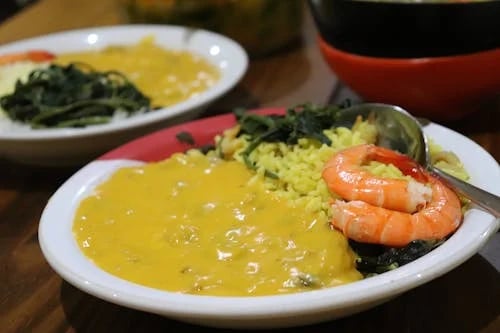Experience the Flavors of Pará's Vatapá
Taste the magic of Belém: Pará-style vatapá! Experience the vibrant flavors and potential health benefits of this local treasure.
HEALTHY DISHES
CILZA DUARTE
4/20/20255 min read


Pará-style Vatapá That Will Transform Your Health
The first time I encountered Pará-style vatapá, I was mesmerized by its golden-orange hue and intoxicating aroma that seemed to dance through the air. This wasn't just another dish—it was a sensory revelation that would redefine my understanding of what truly nourishing food could be. (And believe me, I've explored my fair share of culinary landscapes.)
Have you ever wondered what would happen if the vibrant Amazon rainforest and sun-kissed Mediterranean shores somehow collided on your plate? That's the magic of vatapá—Brazil's unsung health hero that deserves a permanent spot in the global superfood conversation.
When Two Worlds Collide: Amazon Meets Mediterranean
The health world can't stop obsessing over Mediterranean diets. Olive oil this, fresh fish that. The endless parade of Mediterranean-inspired cookbooks could fill an entire library.
But what if I told you that tucked away in northern Brazil's Pará region exists a dish that rivals—and in some nutritional categories, even surpasses—the celebrated Mediterranean diet?
Vatapá, this creamy, aromatic treasure of Pará cuisine, begins with an ingenious combination of ingredients that might seem unlikely partners but create nutritional synergy. Fresh shrimp—sustainably harvested from local waters—provide the foundation for protein that rivals anything you'd find in a Mediterranean fish stew.
The preparation process isn't merely cooking—it's an alchemical transformation where each ingredient contributes to a sum greater than its parts. This meticulous approach mirrors the slow-food philosophies that Mediterranean cultures have practiced for centuries.
The Nutritional Powerhouse You've Never Heard Of
Let's put our nutrition detective hats on for a moment.
Mediterranean diets shine through their balance of omega-3s, healthy fats, and lean proteins. Vatapá delivers this same trifecta through an entirely different ecosystem of ingredients.
The nutritional profile of properly prepared Pará-style vatapá is remarkable:
Shrimp providing high-quality, complete protein and selenium
Coconut milk offering medium-chain triglycerides that support metabolism
Dendê (palm oil) delivering vitamin E and powerful antioxidants
A complex matrix of herbs and spices with anti-inflammatory properties
Na verdade, pensando melhor, the fat composition in vatapá is particularly fascinating. While Mediterranean diets rely heavily on olive oil, vatapá's combination of dendê and coconut creates a lipid profile that some nutrition researchers believe offers unique benefits for sustained energy and cellular health.
"Tu já provaste vatapá paraense?" The Cultural Context
"Have you tried Pará-style vatapá yet?" This question often greets visitors to Belém and surrounding regions. Much like how Mediterranean communities gather around shared meals of paella or bouillabaisse, vatapá brings people together.
It's frequently featured during festive celebrations and family gatherings, where its labor-intensive preparation becomes an act of love and cultural pride. This connection between food and community mirrors the Mediterranean approach to dining—where meals are never just about nutrition, but about nurturing relationships.
I once watched a chef in Belém prepare vatapá, carefully stirring the thick mixture while explaining how his grandmother taught him the exact moment when the dendê oil should be added. "Espera um pouquinho," he cautioned with a knowing smile, demonstrating the patience required for culinary perfection. The cultural reverence was palpable.
The Science Behind the Superfood
What truly connects vatapá to the Mediterranean diet isn't just cultural similarities—it's the underlying nutritional science.
Both dietary approaches feature:
Healthy fats that support brain function and hormone production
High-quality proteins that provide essential amino acids
Complex carbohydrates for sustained energy
A rich spectrum of micronutrients often missing in modern diets
The shrimp in vatapá provide not just protein but also astaxanthin—a powerful antioxidant that some studies suggest may have cardiovascular benefits similar to those found in Mediterranean seafood.
Mediterranean diets are celebrated for their heart-health benefits. Early research indicates that the unique combination of dendê oil's carotenoids, coconut's medium-chain triglycerides, and the anti-inflammatory compounds in vatapá's herbs may offer similar protective effects.
(Though I should note here that moderation is key—dendê oil is calorie-dense and should be enjoyed mindfully as part of a balanced diet.)
From Coast to Table: Sustainability Parallels
One aspect rarely discussed when comparing these two food traditions is their inherent sustainability.
Both the Mediterranean and Amazonian approaches to food emphasize:
Using local, seasonal ingredients
Employing preservation techniques to minimize waste
Creating dishes that honor the bounty of coastal waters
Balancing animal proteins with plant-based components
In an era of industrial food systems, there's something profoundly refreshing about traditions that have sustainability woven into their very fabric.
Traditional vatapá preparation reflects a deep understanding of local ecosystems—utilizing ingredients that are abundant in the region and combining them in ways that maximize both flavor and nutrition. This ecological wisdom parallels the Mediterranean approach of working with what the land and sea naturally provide.
"É de chupar os dedos!" The Flavor Experience
"It'll make you lick your fingers!" This Brazilian expression perfectly captures what happens when you try authentic vatapá for the first time.
The flavor profile is nothing short of transformative:
A rich creaminess from the coconut milk that balances the dendê oil's distinctive character
The sweet brininess of fresh shrimp
Complex undertones from the blend of herbs and aromatics
A subtle warmth from spices that enhances rather than overwhelms
This multidimensional flavor experience parallels the celebrated tastes of Mediterranean cuisine, where each bite reveals new notes and dimensions.
My first taste of proper Pará-style vatapá came paired with perfectly cooked rice and fresh cilantro. The combination was revelatory—showcasing how these regional flavors harmonize in the same way that Mediterranean meals progress through complementary elements.
Bringing Vatapá Into Your Modern Health Journey
Now, I understand that not everyone has access to freshly harvested Amazonian ingredients. Fortunately, the principles behind vatapá can be adapted while maintaining its nutritional philosophy.
For those outside Brazil seeking to incorporate this Amazonian wisdom, consider these principles:
Focus on the quality of your protein sources—sustainably harvested seafood makes a difference
Don't fear healthy, traditional fats—they're essential for nutrient absorption
Embrace aromatic herbs not just as garnishes but as nutritional powerhouses
Honor the cultural context of your food choices
The Mediterranean diet wasn't built in a day, and neither was the traditional Amazonian approach to nutrition. Both evolved over generations of careful observation and cultural wisdom.
When Worlds Truly Collide: A Fusion Approach
Agora, thinking outside the traditional box for a moment, what happens when we actively merge these two nutritional powerhouses?
Imagine vatapá's creamy base used as a sauce for grilled Mediterranean vegetables. Picture jambu (an Amazonian herb with unique properties) sprinkled over a Greek seafood stew. Consider dendê oil drizzled over a traditional Greek salad.
These combinations aren't just culinary experiments—they represent the possibility of creating truly optimal nutritional approaches that transcend geographic boundaries.
My Amazon Food has pioneered several of these fusion approaches, creating accessible pathways for incorporating Amazonian wisdom into various dietary frameworks.
The Future of Global Nutrition Is in the Forest and Sea
What we're really talking about here isn't just a comparison between two regional diets. It's about recognizing that ancient food wisdom often contains solutions to modern health challenges.
The Mediterranean diet gained global recognition because researchers noticed something remarkable: people eating these traditional foods were living longer, healthier lives than those following modern Western diets.
Now, as we turn our attention to the Amazon, we're discovering similar patterns of wisdom—traditional foods that provide remarkable nutritional density while connecting people to their environment and each other.
Pará-style vatapá isn't just a delicious curiosity—it's a window into a comprehensive approach to nutrition that deserves the same respect and scientific attention that Mediterranean traditions have received.
So next time someone raves about their Mediterranean diet plan, perhaps ask them: "But have you tried vatapá?" You might just introduce them to their next health obsession.
After all, sometimes the most profound nutrition discoveries aren't found in laboratories or trendy urban restaurants—they're simmering slowly in traditional pots, tended by hands that have passed down wisdom through countless generations.
What Amazonian treasures will you explore next?
My Amazon Food is dedicated to bringing authentic Amazonian nutrition to health-conscious consumers worldwide. Discover our range of traditional and fusion products at www.myamazonfood.com
Inspiration - Health
Explore recipes, tips, and culinary articles today.
wellness
Flavor
cilzaduarte@gmail.com
55 81 98087-8684
© 2025. All rights reserved.
